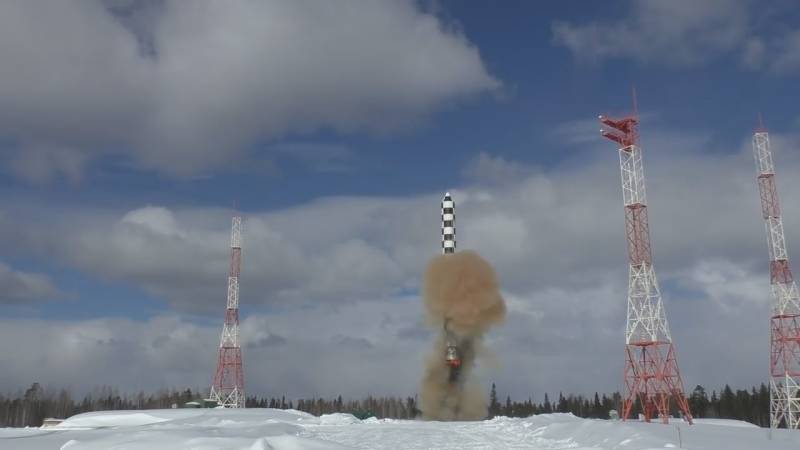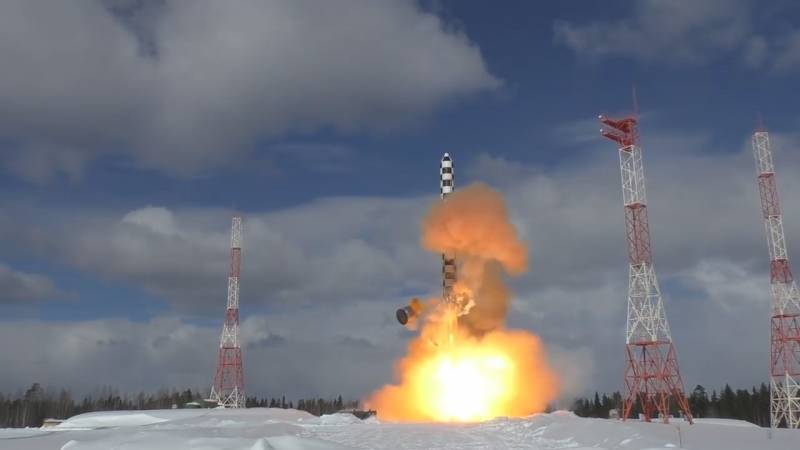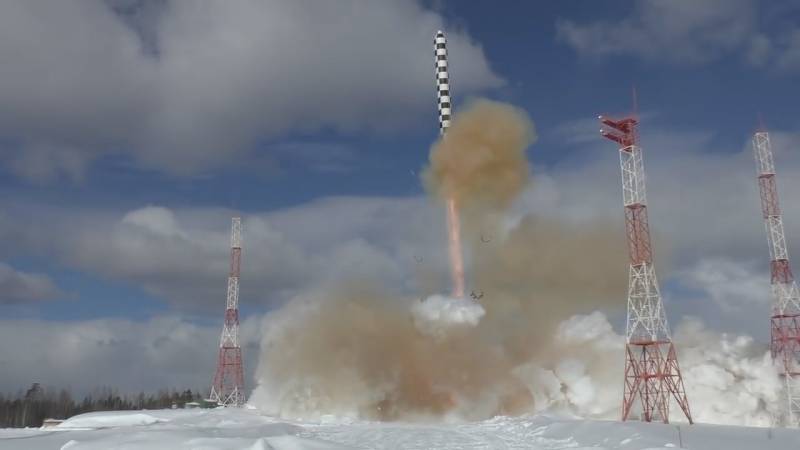Project "Sarmat". Tests in 2019 year, series - in 2021-m
October 2 TASS news agency published new data on the topic of further work in the framework of the Sarmat project. An unnamed source in the defense industry told the agency that the flight tests of the promising missile will begin in the next 2019 year. However, this information was unofficial. Industrial enterprises and the military department did not comment on the new messages.
A TASS source recalled that earlier in 2018, the throwing tests of the RS-28 rocket were conducted, during which the withdrawal of a product from their silo launcher was tested. Two starts ended with positive results, and therefore it was decided to complete the first stage of testing. Thanks to this, the specialists were given the opportunity to begin ground testing of rocket units. The next stage of the work will be flight tests.
Two days later, on October 4, the Sarmat project and its successes were reminded by the Ministry of Defense. The press release on the Day of the Space Forces referred to the successes of the Plesetsk State Test Spaceport, including the successful testing of PC-28 missiles. The Ministry of Defense indicated two launches of the Sarmat ICBM. However, the publication did not mention the fact that these were throwing tests, and not full-fledged flights.
On the same day, it became known how the Russian defense industry is preparing for the future mass production of promising ballistic missiles. The contract for the release of "Sarmatov" is planned to conclude with the Krasnoyarsk Machine-Building Plant. After reconstruction and modernization, this enterprise will be able to assemble missiles of new models, but for the time being it is engaged in manufacturing ballistic missiles of submarines R-29RMU2 "Sineva" and upper stages for launch vehicles of the Sea Launch program.
The plant's general director, Alexander Gavrilov, told reporters about plans for increasing productivity. In connection with the expected increase in the load, the Krasnoyarsk Machine-Building Plant plans to increase the number of employees. From the beginning of the next 2019, it is planned to organize work in two and three shifts. Such an approach to the organization of production will ensure the fulfillment of all existing orders and the timely delivery of various serial products to the Ministry of Defense.
Over the next few weeks, new messages about the Sarmat project itself and supporting processes did not appear. At the same time, an active discussion of the latest news that appeared at the beginning of the month continued. The most interesting new information about the promising ICBM and its future service was published at the very end of the month - October 31.
On the last day of October, TASS published new data from an anonymous source in the military-industrial complex. He said that the end of the flight tests of the promising missile system was set to 2021 a year. Then the industry will have to master the mass production of new weapons and related systems. Finally, in the same 2021 year, the first rocket regiment armed with the Sarmatians will take up combat duty. This will be one of the regiments of the 62 th missile of the Uzhur Red Banner Division of the Strategic Missile Forces.
Information about the deployment of the latest intercontinental ballistic missiles, announced by the TASS source, looks extremely interesting. According to him, the first regiment, which is to be armed with RS-28 missiles, in 2021 will have its own command center and only two mine launchers. In the future, already after 2021, the number of ICBMs on duty will be increased and adjusted in accordance with the required staffing table. In total, the regiment will be on duty with six rocket launchers.
After the rearmament of the 62 th missile division, the Sarmat products will have to be received by other strategic missile forces. However, no information on this has yet been received. However, recently published data suggest that the supply of missiles to other regiments and divisions will begin no earlier than 2022. The required rearmament of the Strategic Missile Forces using new missile systems will take at least several years.
***
According to open sources, the decision to develop a new heavy-class intercontinental ballistic missile appeared at the end of the last decade. This product was intended to gradually replace obsolete ICBMs of the P-36M family, the operation of which should be completed in the foreseeable future. Leading rocket industry enterprises were involved in the development of the new project. The lead performer of the work was the State Rocket Center. V.P. Makeeva (Miass). The development of the rocket ended in 2016 year, after which preparations began for throwing and flight tests.
In 2016, the project encountered some difficulties that affected the timing of the work. Because of the problems with the preparation of the silo launcher at the Plesetsk cosmodrome, as well as due to the need for additional ground tests, the start of throwing tests had to be postponed several times. It was reported that before the end of 2017, the Krasnoyarsk Machine-Building Plant was to produce three Sarmat products in a simplified configuration, intended for the first tests.
At the end of December, 2017, at the Plesetsk test site, the first launch of the RS-28 rocket took place. Later, the first start was confirmed by officials, and in addition, the Ministry of Defense showed the video of these tests. The second launch was launched on 29 March 2018. According to available data, the second rocket was equipped with a first-stage engine. After exiting the launch shaft, the engine turned on and worked for a few seconds.
According to the TASS source, conducting just two throws allowed collecting all the necessary data and refusing the following similar checks. Now the industry is busy preparing for future flight tests, during which experienced missiles will have to carry out a full flight program and conditionally hit remote targets at one of the ranges. The first launch of this kind should take place next year, but the exact date has not yet been named.
From the published data it follows that the PC-28 "Sarmat" product is a three-stage rocket with liquid engines, designed to launch from a mine installation. At different times, different information was given about the tactical and technical characteristics of the new rocket. According to the latest data, the launch weight of the product will reach 200 t. The drop weight is defined in 10 t. The flight distance will exceed 11 thousand km. Accuracy parameters are expected to depend on the type of combat equipment. According to various estimates and data, the Sarmat will be able to carry weapons of different types with differing capabilities.
First of all, the PC-28 missiles will be completed with separable warheads with combat units of individual guidance. At the same time, the possibility of using maneuvering units was mentioned. Of particular interest is a promising hypersonic aircraft Yu-71 / 15YU71 / 4202 / "Avant-garde", equipped with a warhead. The use of such equipment allows you to increase the range of delivery of the warhead, as well as to minimize or eliminate the probability of timely detection and interception by anti-missile defense.
According to known data, the promising heavy ICBM “Sarmat” is intended to replace outdated products of its class. The replacement will be missiles of the Р-36М family and products УР-100НТТТХ. According to open sources, currently on duty is about 75 missiles of these types, operated by three compounds of the Strategic Missile Forces. All this allows us to provide the necessary number of promising missiles, as well as to determine the possible places of their service.
In addition to the issues of replacing existing weapons when drawing up plans for the deployment of the RS-28, the Russian command will have to take into account the conditions of current international agreements. The current START III treaty imposes restrictions on the number of deployed carriers and nuclear warheads. In this regard, the military and political leadership of the country will have to determine what the share of new missiles and their payload will be in the total number of strategic nuclear forces.
It can be noted that as a result of the replacement of obsolete missiles with new PC-28 in the “one to one” ratio, the latter will constitute almost 11% of all carriers in the strategic nuclear forces. According to some estimates, the Sarmat can carry up to ten warheads. In this configuration, new missiles will be able to deliver almost half of all warheads that can be deployed. It is obvious that the similar role of the Sarmat ICBM can lead to one or another problems, and therefore it is worth expecting that the promising complexes will be deployed in smaller quantities and with a different combat load.
***
It should be recalled that the serial production of the promising ballistic missile RS-28 "Sarmat" should start only in 2021 year, and the full re-equipment of one of the regiments of the Strategic Missile Forces will be completed only a year later. A complete abandonment of the obsolete UR-100H UTTH and P-36М in favor of modern products will take several years and may last until the second half of the twenties.
Thus, the issues of deployment and the number of required missiles are still a matter of the distant future. At the moment, the tasks of preparing and conducting flight design tests, according to the results of which the Sarmat can enter into service, are relevant. According to recent reports, the necessary checks will begin next year and may continue until 2021.
Not so long ago, it was argued that the successful conduct of two throwing tests allowed us to abandon new launches of this kind. In addition, this completion of the first tests may be a cause for optimism. It shows that the project is on schedule and without any problems. It remains to hope that the new stages of the Sarmat project will also pass without difficulty, and thanks to this, the Strategic Missile Forces will be able to get a new weapon with special capabilities in time.
On the materials of the sites:
http://tass.ru/
http://iz.ru/
https://rg.ru/
https://vz.ru/
https://tvzvezda.ru/
https://bmpd.livejournal.com/



Information